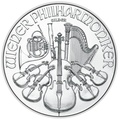Austrian Mint
The Austrian Mint – or Münze Österreich in its native language – is Austria’s national coin mint. The Austrian Mint has a long history dating back to 1194, and rivals the UK’s Royal Mint as one of the world’s most renowned and longest-running coin mints. Today the Austrian Mint produces all of Austria's Euro currency coins for circulation, as well as bullion and commemorative pieces.
The
gold
and
silver
Vienna Philharmonic coin series is the most widely recognised of its bullion coins, and is one of the most popular bullion coins in the world. They are currently the only Euro-denominated bullion coins being minted, making them a firm favourite across the continent.
The Austrian Mint building in central Vienna.
Origins of the Austrian Mint
The mint has a long and, if traditional history is true, extremely colourful past.
King Richard I – known more commonly as Richard the Lionheart – and the Duke of Austria, Leopold V, were both crusaders in the Holy Land. During the Siege of Acre in the spring of 1191, a dispute occurred between the two.
In 1192, en route back to England, Richard was taken prisoner by Duke Leopold. A literal king’s ransom of over 20 tonnes of silver was demanded for the release of Richard. The King's brother, John - who was enjoying ruling England during Richard's absence - refused to pay. Richard's mother, Eleanor of Aquitaine, finally raised the money and paid for his release.
The Innsbruck memorial statue of Duke Leopold V of Austria.
It is claimed that in 1194, Leopold decided to strike coins, and used a large share of the ransom to mint silver Vienna Pfennigs. His Vienna Mint, which struck these Austrian coins, was the foundation for the Vienna Principal Mint.
After the First World War, Austria became a republic, and the Vienna Principal Mint was its only mint. In 1989 the Austrian National Bank officially took control of the mint and changed its name to Münze Österreich.
The Austrian Mint still occupies its prestigious and historic building in the Austrian capital, Vienna. From here it produces around 450 million circulating currency and bullion coins a year, plus gold bars and a range of jewellery.
Austrian Mint gold
In addition to Austrian Mint gold Philharmonics, they also strike Ducats, Guilders and Crown gold bullion coins for investors and coin collectors.
The Austrian Mint also produces gold investment bars. Its minted gold 'Kinebars' are notable for the attractive depiction of the Lipizzaner; the white horse of Vienna’s Spanish Riding School.
Austrian Mint silver coins
The Austrian Mint also produces silver and platinum Philharmonic coins, plus Maria Theresa Thalers. The Thaler was the standard silver coin of the Holy Roman Empire, but was also accepted beyond the Empire’s borders, and was used in the Middle East and Africa. Maria Theresa Thalers are possibly the most famous coin due to her position as Empress; ruler of Austria, Hungary, and Bohemia from 1740 to 1780.
The coins were first minted in 1741. Today, the Austrian Mint strikes reproduction souvenirs of the original 1780 coins.
- How To Buy Gold
- How to Buy?
- Payment Options
- Delivery Options
- Gold Storage
- Storage at Brink's
- Gold Investment Guide
- Why buy gold?
- Is gold a good investment?
- Why physical gold?
- Best time to buy gold?
- Gold bars vs coins?
- Gold vs Silver
- Gold - Silver Ratio explained
- VAT on bullion
- CGT on bullion
- Legal tender coins
- Top 5 Gold Investments
- Top 5 Silver Investments
- Gold vs ISAs
- Gold vs Buy-to-Let
- Gold vs FTSE 100
- Gold vs Bitcoin
- Where to buy gold?
- Why buy from us?
- Where to sell gold?
- Coin Shops
- Gold Price Forecasts
- Top 10 Gold Producers
- Top 10 Gold Reserves
- Gold Britannia vs Sovereign
- Britannia coin designs
- Sovereign coin designs
- Sovereign Mintages
- Sovereign mint marks
- British coin specs
- What is a proof coin?
- Royal Mint bullion
- The Queen's Beasts
- Royal Mint Lunar Coins
- Bullion Refiners
- British coin mints
- Krugerrands
- Gold Tola - India & Pakistan
- Bullion Index











